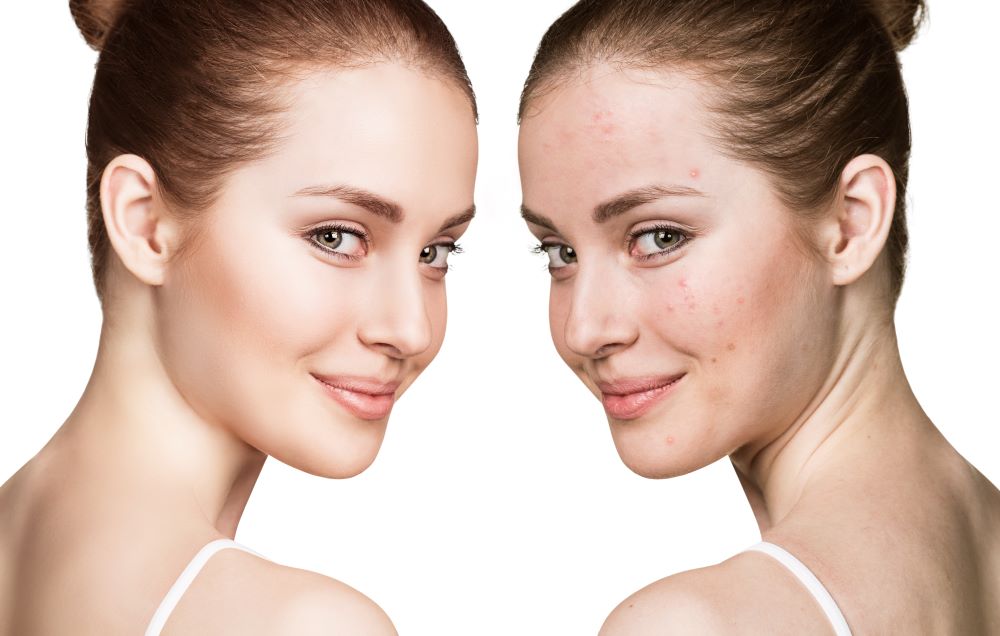Rosacea, auch Rotfinnen oder Kupferakne genannt, ist eine Hautkrankheit, die vorwiegend im Bereich des Mittelgesichts auftritt. Sie beginnt in der Regel zwischen dem 30. und 40. Lebensjahr und verschlimmert sich oft zwischen dem 40. und 50. Rosazea hat Ähnlichkeiten mit Akne, wird aber von anderen Problemen begleitet. Rosacea ist eine chronische und fortschreitende entzündliche Hauterkrankung, die typischerweise das Gesicht betrifft. Sie kann zu Rötungen, Schwellungen, Bläschen, Knötchen und Gewebebildung führen. Die Betroffenen leiden unter Juckreiz und Schmerzen sowie unter kosmetischen Beeinträchtigungen.
Was ist Rosacea?
Rosazea (früher auch als "Kupferrose" bekannt) ist eine nicht ansteckende, chronisch entzündliche Hauterkrankung (Dermatose). Sie betrifft vor allem das Gesicht, insbesondere die Nase und die Wangen, kann aber auch die Stirn und das Kinn betreffen. In seltenen Fällen können auch angrenzende Regionen wie die Kopfhaut, der Hals oder das Dekolleté betroffen sein.
Der Schweregrad der Rosazea kann sich anfangs nur durch eine vorübergehende Rötung (Rosazea-Diathese) bemerkbar machen, in fortgeschrittenen Stadien jedoch sehr viel schwerwiegender werden, bis hin zu dauerhaften Veränderungen des Bindegewebes.
Diese Hauterkrankung betrifft Menschen jeden Alters, obwohl sie vor allem Menschen in den mittleren und späten Lebensjahren betrifft. Nach den derzeitigen Erkenntnissen sind Männer und Frauen gleichermaßen betroffen.
Da Rosacea entzündliche Hautveränderungen aufweist, die der Akne ähneln, wird die Krankheit manchmal auch als "Akne-Rosacea" bezeichnet. Im Gegensatz zu Aknepatienten entwickeln Menschen mit Rosazea jedoch keine Mitesser. Wenn bei Ihnen die Symptome beider Erkrankungen gleichzeitig auftreten (Mitesser und Rötungen), ist es wahrscheinlich, dass Sie an einer Mischform der beiden Krankheiten leiden.
Auslöser von Rosacea?
Die genauen Ursachen der Rosacea sind nach wie vor unbekannt. Es wird vermutet, dass Rosazea mit erblichen Faktoren zusammenhängt. Viele Menschen, die an Rosazea leiden, haben Familienmitglieder, die ebenfalls daran erkrankt sind. Da hellhäutige Menschen west- und nordeuropäischer Abstammung häufiger an Rosacea erkranken, hat sich in der angloamerikanischen Literatur der Begriff "Fluch der Kelten" eingebürgert.
Die durch Sonneneinstrahlung verursachte Schädigung der Gesichtshaut ist wahrscheinlich ein Faktor bei der Entstehung von Rosacea. Sie wirkt sich sowohl auf das Bindegewebe als auch auf die Blut- und Lymphgefäße aus und führt zu Gefäßerweiterungen und Entzündungen. Aktuellen Studien zufolge führt eine falsche angeborene Immunreaktion zu einer Hautentzündung. Demodex-Milben, die ein fester Bestandteil der Krankheit sind, scheinen eine Rolle bei der Entzündung zu spielen. Cathelicidin, ein natürliches antimikrobielles Proteinpartikel (Peptid), das Teil des angeborenen Immunsystems ist, scheint zumindest zum Teil an der Entzündung beteiligt zu sein. Erhöhte Werte von Cathelicidin, einer Art von antimikrobiellen Peptiden, die von den Hautzellen als Teil des angeborenen Immunsystems produziert werden, können zu den Rosazea-Symptomen beitragen.
Die Immunzellen in den betroffenen Bereichen setzen Stoffe frei, die die Gefäße erweitern und eine Entzündung verursachen. Diese übermäßige Teilung des Bindegewebes und der Talgdrüsen führt an manchen Stellen zu einer Verdickung der Haut und lässt die Poren größer erscheinen.
Wie kann sich Rosacea verschlimmern?
Es ist wichtig, die typischen Auslöser für Rosazea-Schübe zu vermeiden. Dies sind einige von ihnen:
- Hitze, heiße Bäder und Duschen,
- Saunabesuche
- Waschlotionen und Seifen mit einem alkalischen pH-Wert (7)
- Bestimmte Kosmetika
- Bestimmte Medikamente
- Stress
- Alkohol
- Scharf gewürzte Gerichte
- Warme Getränke
- Sonneneinstrahlung
Rosacea kann durch Ereignisse ausgelöst werden, die Sie vielleicht gar nicht wahrnehmen. Ereignisse, die ein Aufflackern der Rosacea verursachen, können unmerklich sein. Denken Sie daran, dass Ihre Haut nicht unterscheiden kann, was real ist und was nicht.
Ein Aufflackern der Krankheit kann durch hormonelle Veränderungen verursacht werden, z. B. während der Schwangerschaft. Sprechen Sie unbedingt mit Ihrem Arzt über diese Möglichkeit.
Da jeder Mensch unterschiedlich auf mögliche Auslöser reagiert, sollten Sie genau beobachten, auf welche Reize Ihre Haut reagiert und Ihren Lebensstil gegebenenfalls anpassen.
Rosacea Diagnose
Der Dermatologe (Hautarzt) wird die Haut genau untersuchen und die Person nach ihrer Krankengeschichte und erschwerenden Faktoren befragen, um eine Rosacea zu diagnostizieren.
Manchmal ist es sinnvoll, eine Hautprobe (Biopsie) aus dem Gesichtsbereich zu entnehmen und sie unter Vergrößerung zu untersuchen. Auf diese Weise können ähnlich aussehende Krankheiten wie Lupus erythematosus (auch Roter Wolf genannt) oder periorale Dermatitis definitiv ausgeschlossen werden. Zur Diagnose von Rosacea können auch Bluttests erforderlich sein. Wenn der Dermatologe den Verdacht hat, dass Rosacea die Augen betrifft, wird er den Patienten für weitere Tests an einen Augenarzt überweisen.
Rosacea Symptome
Rosazea ist durch drei Hauptsymptome gekennzeichnet: Rötungen, Erytheme und Teleangiektasien. Flushing bezeichnet plötzliche Rötungen und Wärme auf der Haut, Erythem ist eine anhaltende Rötung der Haut und Teleangiektasie ist eine sichtbare Erweiterung der Blutgefäße.
Später können Papeln (Hautverdickungen) und mit Eiter gefüllte Bläschen (Pusteln) sowie Lymphgefäßschwellungen (Lymphödeme) auftreten.
Andere Veränderungen Ihrer Haut können Stumpfheit, trockene Flecken, Plaques, Entzündungen (Ödeme) und übermäßige Talg- und Bindegewebswucherungen (Phyme) sein.
Die häufigsten Symptome sind brennende, stechende oder schmerzende Haut und ein Hitzegefühl. In einigen Fällen sind auch die Augen betroffen. Dies zeigt sich in erweiterten Blutgefäßen in den Augen und wiederkehrenden trockenen und entzündeten Augen.
Schweregrade bei Rosacea
Rosacea ist eine Hauterkrankung, die sich in Schüben verschlimmert und unterschiedliche Schweregrade aufweist. Die Krankheit wird von den folgenden Symptomen begleitet:
- Vorstadium – Rosacea-Diathese: Das erste Symptom der Rosazea sind typischerweise Rötungen. Diese treten nur im Gesicht auf, können sich aber auch am Hals, auf der Brust, der Kopfhaut oder den Augen zeigen.
- Schweregrad I – Rosacea erythematosa-teleangiectatica: Telangiektasien sind Blutgefäßerweiterungen, die häufig auf der Gesichtshaut auftreten. Zusätzlich zu den Rötungen leiden die Betroffenen oft unter trockener und juckender Haut sowie brennenden oder stechenden Schmerzen.
- Schweregrad II – Rosacea papulopustulosa: In diesem Stadium der Rosazea treten vermehrt rote und entzündete Bläschen oder Pusteln (umgangssprachlich als Pickel bezeichnet) und Knötchen (Papeln) auf. Sie können manchmal einige Wochen andauern. Außerdem kann es zu Schwellungen (Lymphödemen) im Gesichtsgewebe kommen.
- Schweregrad III – Glandulär-hyperplastische Rosacea: Dies ist die schwerste Form der Rosazea. Das Bindegewebe und die Talgdrüsen nehmen an Größe zu, was zu wulstigen Wucherungen (Phyma) führt, wie zum Beispiel einer "Knollennase" oder "Kartoffelnase" (Rhinophym). Diese Veränderungen haben häufig einen erheblichen Einfluss auf das Aussehen der Betroffenen.
Die Symptome der Rosacea unterscheiden sich oft von Patient zu Patient, so dass es schwierig sein kann, ihnen einen Schweregrad zuzuordnen. Deshalb verwenden immer mehr Experten ROSCO, ein modulares System zur Messung des Schweregrads der Krankheit. Die primären und sekundären Symptome werden danach kategorisiert, wie häufig, wie stark und wie lange sie bei den Patienten auftreten. So können Ärzte ihre Patienten je nach Schweregrad der Symptome besser behandeln.
Rosacea selbst behandeln
Die Behandlung der Rosazea beginnt mit der Vermeidung von Dingen, die die Krankheit auslösen oder ihr Fortschreiten fördern. Dazu gehören Nahrungsmittel und Umweltfaktoren, denen die Haut ausgesetzt ist, wie z.B. extreme Sonneneinstrahlung oder Temperaturschwankungen.
Hausmittel zur Behandlung von Rosacea, wie Apfelessig, Kamillentee, grüner Tee, Honig und andere Dinge finden Sie im Internet. Aufgrund der extrem empfindlichen Haut von Menschen mit Rosacea sollten Sie vor der Anwendung dieser Mittel unbedingt einen Hautarzt aufsuchen. Der Arzt wird Ihnen mitteilen, ob die Anwendung für Sie in Ordnung und sicher ist. Wenn Ihre Haut nach der Anwendung auf eine Art und Weise reagiert, die Sie nicht mögen, kann der Arzt sich auch um die Folgen kümmern und andere Lösungen vorschlagen.
Was hilft gegen Rosacea?
Rosacea ist eine chronische Erkrankung, die immer eine langfristige Behandlung und regelmäßige Kontrolluntersuchungen beim Hautarzt erfordert. Medikamente sollten jedoch nur als ein Teil der Gesamtstrategie gesehen werden.
Vermeiden Sie Verstärker
Wer unter Rosacea leidet, sollte vermeiden, die Symptome zu verschlimmern. Dies sind einige der Dinge, die vermieden werden sollten:
- Sonnenlicht
- scharf gewürzte Speisen
- warme Getränke
- Alkohol
- Stress
Medikamente wie Kalziumantagonisten können Rötungen im Gesicht verursachen. Wenn Sie glauben, dass Ihr Medikament diese Wirkung hat, sprechen Sie mit Ihrem Arzt darüber. Brechen Sie die Einnahme des Medikaments nicht ab, ohne vorher mit Ihrem Arzt gesprochen zu haben!
Stress reduzieren
Der Umgang mit Stress kann schwierig sein, aber es gibt eine Reihe von Möglichkeiten, damit umzugehen. Neben individuellen Strategien können auch Entspannungsmethoden wie die progressive Muskelentspannung und autogenes Training hilfreich sein.
Hautpflegemittel und Kosmetika
Menschen, die unter Rosacea leiden, können Maßnahmen ergreifen, um die Anzeichen und Symptome ihrer Erkrankung zu lindern. Auch mit einer angemessenen Hautpflege können Menschen mit Rosacea eine Menge tun, um die Symptome zu lindern. Für das Gesicht sollten nur milde, seifenfreie, pH-neutrale Waschlotionen oder Syndets verwendet werden, da die empfindliche Haut gereizt werden kann.
Bei der Auswahl von Kosmetika sollten Sie sorgfältig auf die Inhaltsstoffe achten. Es ist wichtig, die Bestandteile sorgfältig zu prüfen. Menthol und Kampfer sind zwei Beispiele für Inhaltsstoffe, die Menschen mit Rosacea vermeiden sollten. Präparate auf Glycerin- oder Silikonölbasis werden in der Regel gut vertragen.
Die mit Rosacea verbundenen Hautveränderungen sind für viele Betroffene ein kosmetisches Problem. Das Abdecken der Rötungen mit speziellen Produkten (Camouflage) ist sehr wirksam. Besonders hilfreich sind Produkte, die grüne Pigmente enthalten und so die Rötungen im Gesicht optisch reduzieren.
Tagespflege mit Sonnenschutz
Viele Menschen berichten, dass sich ihre Symptome verschlimmern, wenn sie intensivem Sonnenlicht ausgesetzt sind. Daher wird den Patienten empfohlen, ausgedehnte Sonnenbäder zu vermeiden und Sonnenschutzmittel mit Wirkung gegen UV-A- und UV-B-Strahlen zu verwenden. Da chronische Sonneneinstrahlung bei der Entstehung und Aufrechterhaltung der Krankheit eine wichtige Rolle spielt, wird die ganzjährige Verwendung eines für den Hauttyp geeigneten Sonnenschutzmittels empfohlen.
Kaltes Getränk oder Eiswürfel
Plötzliche Gesichtsrötungen können durch den Konsum von kalten Getränken oder das Lutschen von Eiswürfeln behoben werden.
Massagen für das Gesicht
Gesichtsmassagen können helfen, die durch Rosacea verursachten Schwellungen zu reduzieren. Entzündungen verursachen Schwellungen, die durch Muskelaktivität nicht verbessert werden. Sie sind im Gesicht zu finden und werden durch Muskelanspannung nicht beeinträchtigt.
Ernährung
In den meisten Fällen lassen sich die Symptome relativ leicht unter Kontrolle bringen. Indem man die Ursachen der Krankheit beseitigt, kann man ein erneutes Auftreten der Krankheit verhindern. Alkohol, insbesondere heiße Getränke und scharfe Speisen, haben eine gefäßerweiternde Wirkung und sollten in erster Linie vermieden werden. Fettleibigkeit und chronische Entzündungen sind in mehrfacher Hinsicht miteinander verbunden. Fettleibigkeit ist wie andere entzündliche Krankheiten mit dem Verzehr von entzündungsfördernden Lebensmitteln verbunden. Die Krankheit kann durch eine Gewichtsreduktion verbessert werden. Intermittierendes Fasten hilft bei der Entgiftung der Leber - der natürlichen Reinigungskraft unseres Körpers - und reduziert gleichzeitig das Gewicht. Bittere Pflanzen, wie Chicorée und Rucola, fördern die Leberfunktion. Für ein stärkeres Immunsystem nehmen Sie am besten Probiotika zu sich und halten eine entzündungshemmende Diät ein, bei der Sie auf Zucker, fettes Fleisch, Weizen - und wenn möglich Milchprodukte - verzichten.
Gesichts-Creme, -Lotion oder -Salbe bei Rosacea
Salben bestehen vollständig aus Fett und enthalten kein Wasser, während Cremes einen gewissen Anteil an Wasser enthalten. Lotionen enthalten sogar mehr Wasser als Fett und werden daher als Öl-in-Wasser-Emulsionen bezeichnet.
Da Cremes und Lotionen einen hohen Wassergehalt haben, sind sie ideal für Rosacea-Patienten. Sie bilden keinen fettigen Film auf der Haut, der die Poren verschließt, wie andere Produkte. Stattdessen lassen sie die Haut atmen, ohne sie auszutrocknen.
Produkte mit zugesetzten Duft- oder Farbstoffen können Hautreizungen verursachen und sollten bei empfindlicher Haut vermieden werden. Sprechen Sie mit einem Apotheker, bevor Sie neue Hautpflegeprodukte kaufen, um sich persönlich beraten zu lassen.
Rosacea Medikamente
Die meisten Fälle von Rosacea werden mit Medikamenten behandelt, sowohl äußerlich als auch innerlich.
Äußerliche Therapie
Metronidazol wird am häufigsten als Creme, Gel oder Lotion verwendet. Der Wirkmechanismus von Metronidazol ist derzeit nicht bekannt; wahrscheinlich hat es eine entzündungshemmende Wirkung. Azelainsäure ist eine weitere gängige Rosazea-Therapie in Form eines Gels. Außerdem hemmt dieser Wirkstoff die Entzündung. Seit kurzem ist Ivermectin in Cremeform zur Behandlung von Rosacea erhältlich, indem es die Demodex-Milbe und die damit verbundenen Entzündungen reduziert. Eine weitere Möglichkeit, die Rötungen zu lindern, sind Wirkstoffe wie Bromonidin, der die Blutgefäße verengt.
Es muss jedoch beachtet werden, dass Rosacea niemals über einen längeren Zeitraum mit kortisonhaltigen Medikamenten behandelt werden sollte, da dies die Hauterkrankung verschlimmern würde.
Innerliche Therapie
Wenn sich die Symptome durch äußerliche Behandlungen wie Cremes oder Salben nicht bessern oder wenn die Entzündung schwerwiegend ist, kann ein Arzt Antibiotika verschreiben. Tetracycline - wie Minocyclin oder Doxycyclin - haben sich bei der Behandlung von Rosacea bewährt. Doxycyclin wird in der Regel bevorzugt, weil es in einem speziellen Präparat und in niedrigen Dosen erhältlich ist, die das Bakterienwachstum nicht beeinträchtigen. Daher wirkt es ausschließlich gegen Entzündungen und ist gut verträglich.
Isoretinoin (ein Vitamin-A-Derivat) wird in Kapselform verabreicht. Dabei handelt es sich jedoch um eine Off-Label-Anwendung, die der Arzt und der Patient eingehend besprechen und vereinbaren müssen. Wenn Tetracycline unwirksam oder unerwünscht sind, hat sich Isotretinoin als erfolgreich erwiesen. Isoretinoin kann zur Behandlung eines leichten Rhinophyms verschrieben werden, da es das Volumen reduziert. Wenn dies jedoch die gewählte Behandlungsform ist, dürfen schwangere Frauen und Frauen im gebärfähigen Alter es nicht einnehmen, da es zu Missbildungen beim ungeborenen Kind führen kann. Außerdem müssen alle Patienten, die Isoretinoin einnehmen, eine sichere Verhütungsmethode anwenden. Während der Therapie sind außerdem regelmäßige Blutuntersuchungen (Leberwerte, Blutfette) erforderlich. Wenn eine Demodex-Infektion bestätigt wird, kann Permethrin, ein Wirkstoff gegen den Parasiten, eingesetzt werden, um die Anzahl der Milben zu reduzieren. Da es sich jedoch um eine Anwendung handelt, die über den Rahmen der Zulassung hinausgeht, müssen der Arzt und der Patient dies im Detail durchgehen und vereinbaren. Permethrin ist keine Langzeittherapie für Rosacea.



